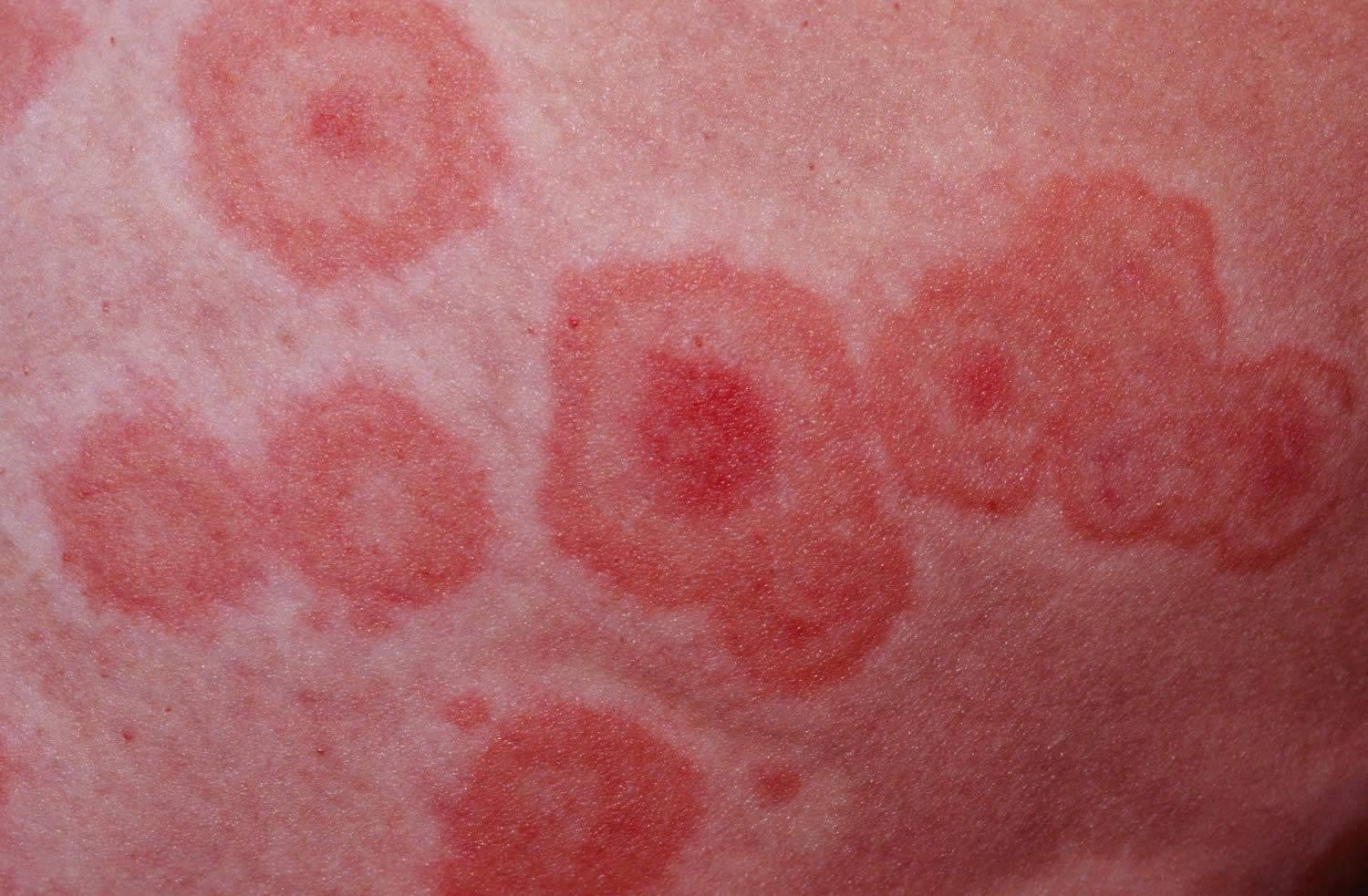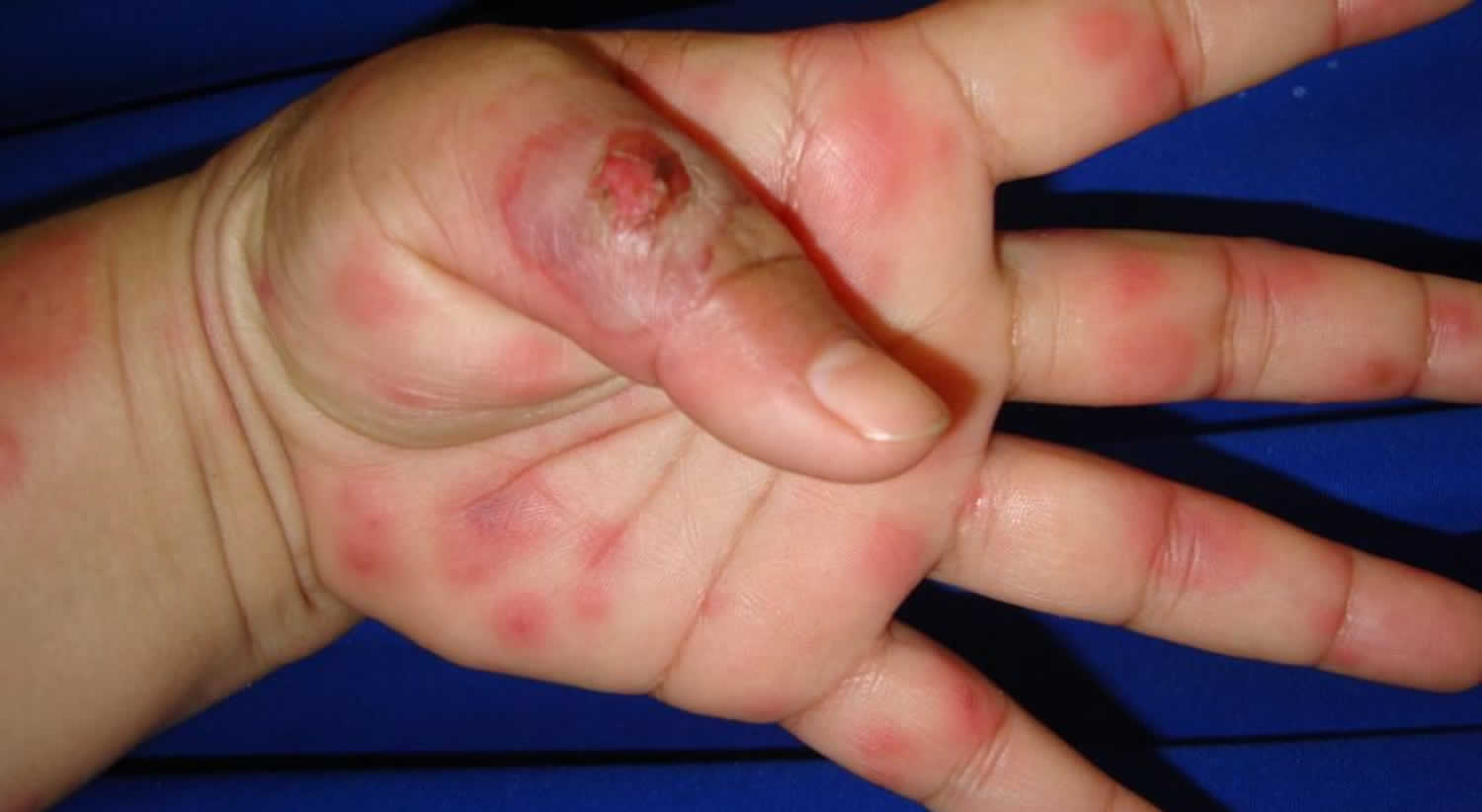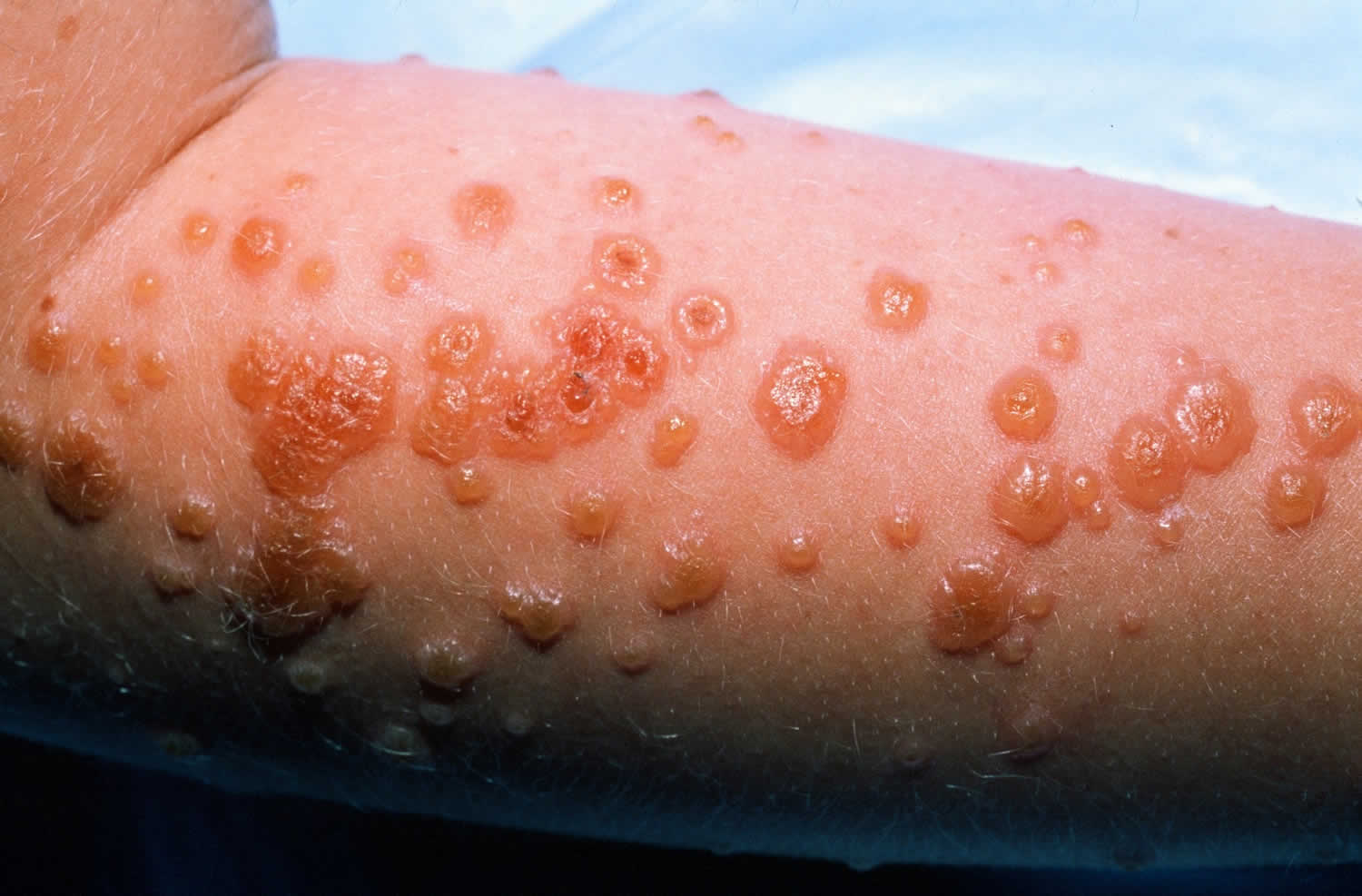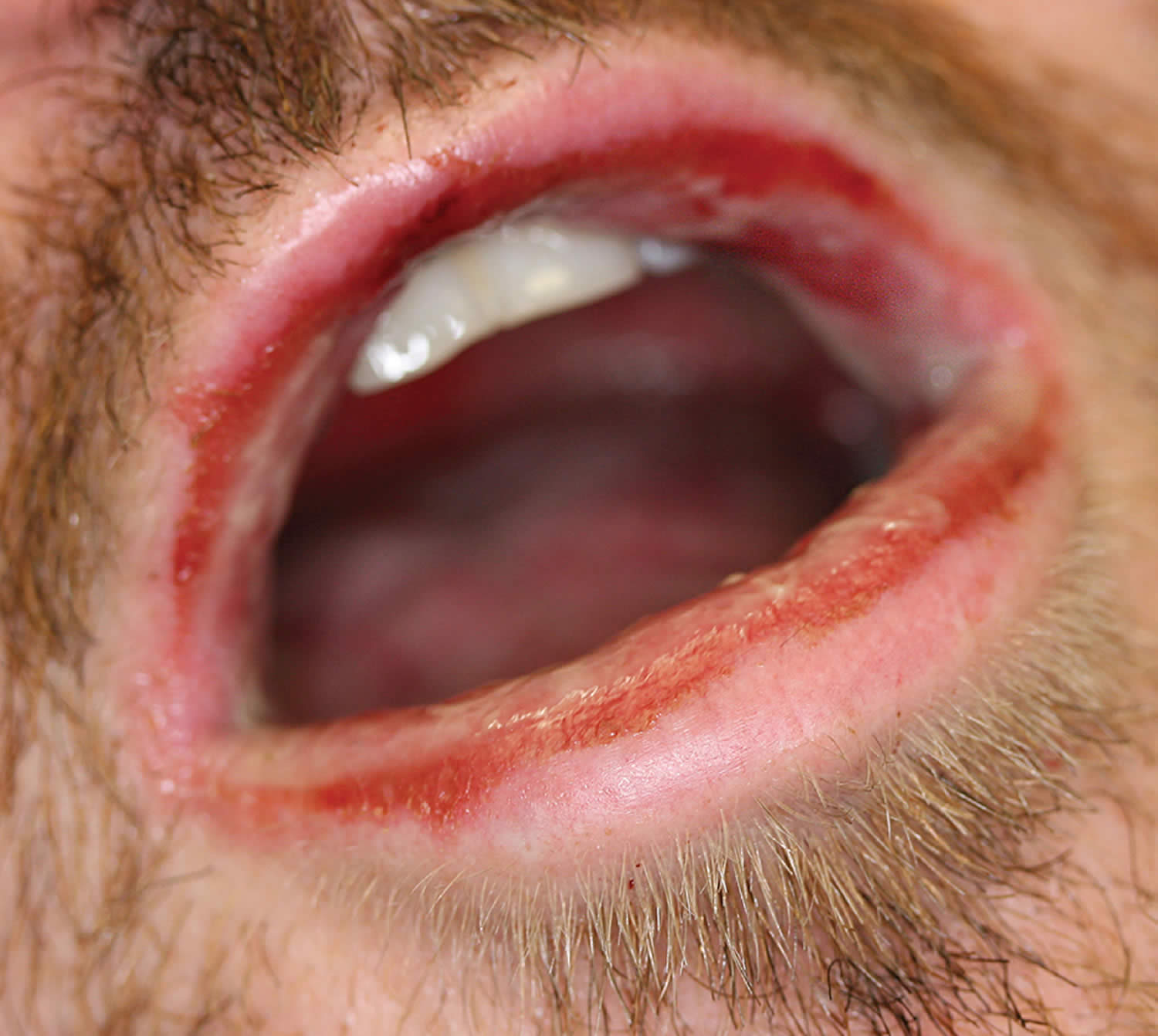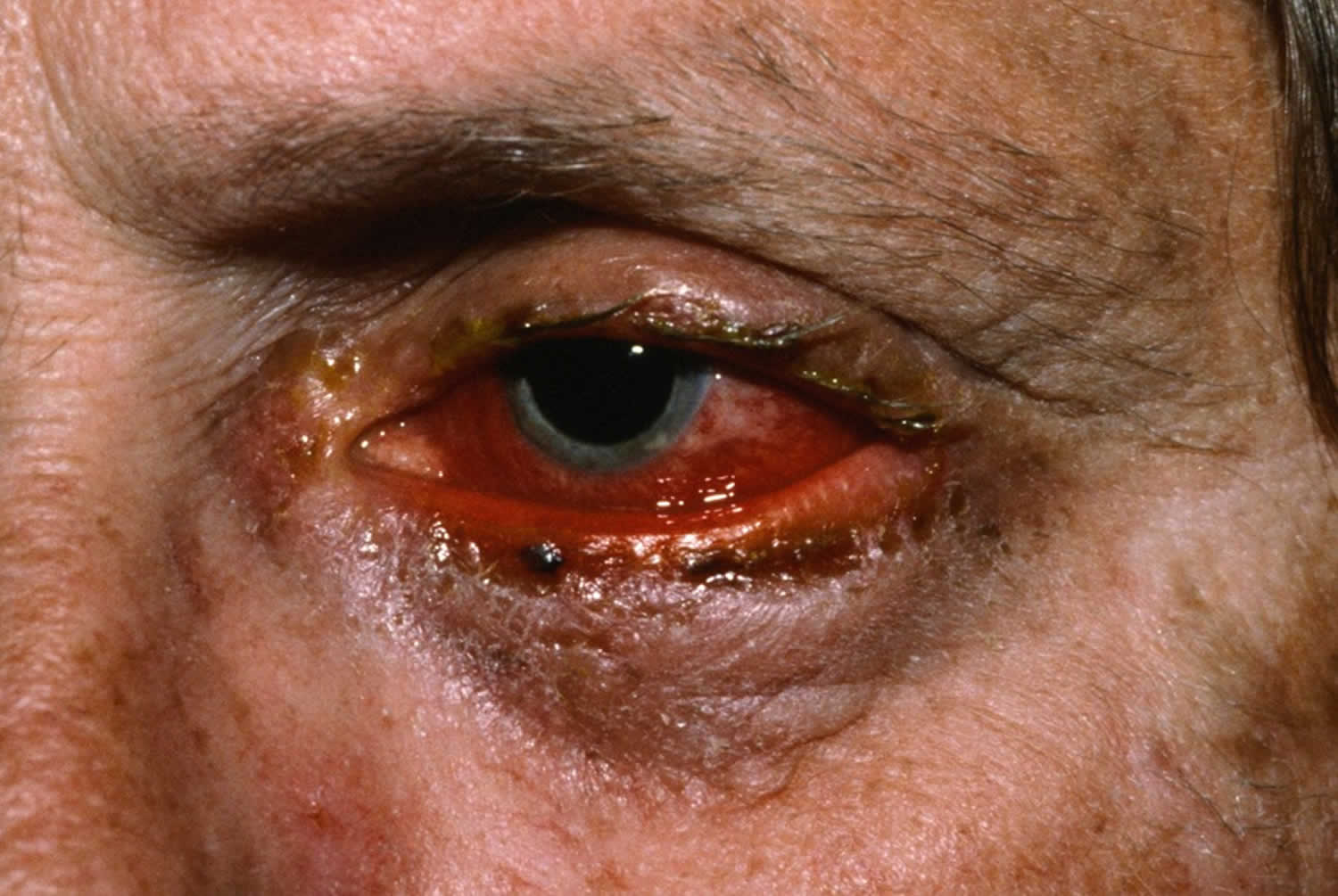Contents
What is erythema multiforme
Erythema multiforme is a hypersensitivity reaction usually triggered by infections, most commonly herpes simplex virus (HSV). Erythema multiforme is a type of allergic reaction. In rare cases, erythema multiforme is caused by certain medicines or body-wide (systemic) illness. Erythema multiforme presents with a skin eruption characterized by a typical target lesion. There may be mucous membrane involvement. It is acute and self-limiting, usually resolving without complications.
There are 2 forms of erythema multiforme:
- Erythema multiforme minor usually involves the skin and sometimes mouth sores.
- Erythema multiforme major often starts with a fever and joint aches. Besides the skin sores and mouth sores, there may be sores in the eyes, genitals, lung airways, or gut and can be life-threatening.
Erythema multiforme is now regarded as distinct from Stevens–Johnson syndrome and toxic epidermal necrolysis.
Erythema multiforme most commonly affects young adults (20–40 years of age), however all age groups and races can be affected. There is a male predominance. People with erythema multiforme often have family members who have had erythema multiforme as well.
There is a genetic tendency to erythema multiforme. Certain tissue types are more often found in people with herpes-associated erythema multiforme (HLA-DQw3) and recurrent erythema multiforme (HLA-B15, -B35, -A33, -DR53, -DQB1*0301).
Erythema multiforme usually goes away on its own with or without treatment.
Recurrent erythema multiforme
Erythema multiforme can be recurrent, with multiple episodes per year for many years. This is believed to be nearly always due to herpes simplex virus-1 infection.
Figure 1. Erythema multiforme
Figure 2. Erythema multiforme
Figure 3. Erythema multiforme toddler
Figure 4. Bullous erythema multiforme
Figure 5. Erythema multiforme major lips
Figure 6. Erythema multiforme major eye
Is erythema multiforme contagious?
No. Erythema multiforme can’t be passed from person to person. Erythema multiforme is a type of allergic reaction and in some cases are the result of a reaction to an infection (e.g., herpes simplex virus, mycoplasma) or medication.
Erythema multiforme prognosis
Erythema multiforme minor usually resolves spontaneously without scarring over 2–3 weeks. Erythema multiforme major can take up to 6 weeks to resolve. Erythema multiforme does not progress to Stevens–Johnson syndrome or toxic epidermal necrolysis.
There may be residual mottled skin discoloration. Significant eye involvement in erythema multiforme major may rarely result in serious problems, including blindness.
In severe cases, possible complications can include:
- blood poisoning (septicemia)
- septic shock (where blood pressure drops to a dangerously low level)
- a skin infection (cellulitis)
- permanent skin damage and scarring
- permanent eye damage
- inflammation of internal organs, such as the lungs or liver
Erythema multiforme symptoms
There are usually no prodromal symptoms in erythema multiforme minor. However, erythema multiforme major may be preceded by mild symptoms such as fever or chills, weakness, itchy skin or painful joints.
Skin sores may:
- Start quickly
- Come back
- Spread
- Be raised or discolored
- Look like hives
- Have a central sore surrounded by pale red rings, also called a target, iris, or bulls-eye
- Have liquid-filled bumps or blisters of various sizes
- Be located on the upper body, legs, arms, palms, hands, or feet
- Include the face or lips
- Appear evenly on both sides of the body (symmetrical)
Additional symptoms of erythema multiforme may include:
- Bloodshot eyes
- Dry eyes
- Eye burning, itching, and discharge
- Sore, red eyes
- Sensitivity to light and blurred vision
- Raw sores inside your mouth, making it hard to eat and drink
- Swollen lips covered in crusts
- Vision problems
- A high temperature (fever) of 100.4 °F (38 °C) or more
- A headache
- Feeling generally unwell
- Sores on the genitals, making it painful to pee
- Aching joints
Skin lesions
Typically in erythema multiforme, few to hundreds of skin lesions erupt within a 24-hour period. The lesions are first seen on the backs of hands and/or tops of feet, and then spread along the limbs towards the trunk. The upper limbs are more commonly affected than the lower. Palms and soles may be involved. The face, neck and trunk are common sites. Skin lesions are often grouped on elbows and knees. There may be an associated mild itch or burning sensation.
The initial lesions are sharply demarcated, round, red/pink and flat (macules), which become raised (papules/palpable) and gradually enlarge to form plaques (flat raised patches) up to several centimeters in diameter. The center of the papule/plaque darkens in color and develops surface (epidermal) changes such as blistering or crusting. Lesions usually evolve over 72 hours.
The typical target lesion (also called iris lesion) of erythema multiforme has a sharp margin, regular round shape and three concentric color zones:
- Center is dusky or dark red with a blister or crust
- Next ring is a paler pink and is raised due to edema (fluid swelling)
- Outermost ring is bright red.
Atypical target lesions show just two zones and/or an indistinct border.
The eruption is polymorphous (many forms), hence the ‘multiforme’ in the name. Lesions may be at various stages of development with both typical and atypical targets present at the same time. A full skin examination may be required to find typical targets, as these may be few in number.
Lesions show the Köbner (isomorphic) phenomenon, meaning they can develop at sites of preceding (but not concurrent or subsequent) skin trauma.
There is no associated swelling of face, hands or feet, despite these being common sites of rash distribution. However the lips are often swollen, especially in erythema multiforme major.
Mucous membrane involvement
Mucosal lesions, if present, typically develop a few days after the skin rash begins.
In erythema multiforme minor, mucous membrane involvement is absent or mild. Mucosal changes, if present, consist initially of redness of the lips and inside cheek. Sometimes blisters develop and quickly break to form erosions and ulcers.
In erythema multiforme major, one or more mucous membranes are typically affected, most often the oral mucosa:
- Most commonly lips, inside the cheeks, tongue
- Less commonly floor of the mouth, palate, gums.
Other mucosal sites affected may include:
- Eye
- Anus and genitals
- Trachea/bronchi
- Gastrointestinal tract.
Mucosal lesions consist of swelling and redness with blister formation. The blisters break quickly to leave large, shallow, irregular shaped, painful ulcers that are covered by a whitish pseudomembrane. Typically the lips are swollen with hemorrhagic crusts. The patient may have difficulty speaking or swallowing due to pain. These symptoms are more common in erythema multiforme major or a similar condition called Stevens-Johnson syndrome.
With mycoplasma pneumonia, the mucous membranes may be the only affected sites (mucositis). This can be severe and require hospitalization due to difficulty eating and drinking. Whether this is a limited form of erythema multiforme has not been determined. It is also known as Fuchs syndrome, and mucosal erythema multiforme may occasionally be due to recurrent herpes simplex.
Erythema multiforme causes
The cause of erythema multiforme is often unclear, but some cases are the result of a reaction to an infection or medication.
Erythema multiforme can’t be passed from person to person.
Infections
Infections are probably associated with at least 90% of cases of erythema multiforme.
The single most common trigger for developing erythema multiforme is herpes simplex virus (HSV) infection, usually herpes labialis (cold sore on the lip) and less often genital herpes. Herpes simplex virus type 1 is more commonly associated than herpes simplex virus type 2. The herpes infection usually precedes the skin eruption by 3–14 days.
Mycoplasma pneumonia (a lung infection caused by the bacteria Mycoplasma pneumoniae) is the next most common trigger.
Many different virus infections have been reported to trigger erythema multiforme including:
- Parapoxvirus (orf and milkers’ nodules)
- Herpes varicella zoster (chickenpox, shingles)
- Adenovirus
- Hepatitis viruses
- Human immunodeficiency virus (HIV)
- Cytomegalovirus
- Viral vaccines
Dermatophyte fungal infections (tinea) have also been reported in association with erythema multiforme.
Medications
Medications are probably an uncommon cause (<10%) of erythema multiforme. If this diagnosis is being seriously considered then alternative drug eruptions should be excluded, such as Stevens–Johnson syndrome/toxic epidermal necrolysis, generalized fixed drug eruption, polymorphic exanthematous drug eruption and urticaria.
Many drugs have been reported to trigger erythema multiforme, including:
- antibiotics, such as penicillins, sulfonamides, tetracyclines, amoxicillin and ampicillin;
- non-steroidal anti-inflammatory drugs (NSAIDs) such as ibuprofen,
- anticonvulsants (used to treat epilepsy) such as phenytoin and barbiturates
- antipsychotic such as phenothiazines
- allopurinol (treats gout)
Systemic illnesses
Systemic illnesses that are associated with erythema multiforme include:
- Inflammatory bowel disease, such as Crohn disease
- Systemic lupus erythematosus
Erythema multiforme diagnosis
Erythema multiforme is a clinical diagnosis, although skin biopsy may be required to exclude other conditions. The histology of erythema multiforme is characteristic but not diagnostic. It varies with the age of the lesion, its appearance, and which part is biopsied.
Other tests may be done looking for infections commonly seen in association with erythema multiforme, such as mycoplasma.
Erythema multiforme treatment
For the majority of cases, no treatment is required, as the rash settles by itself over several weeks without complications.
If a drug cause is suspected then the possible offending drug should be ceased. Your healthcare provider will have you stop taking any medicines that may be causing the problem. But, don’t stop taking medicines on your own without talking to your provider first.
Treatment directed to any possible cause may be required such as oral aciclovir (not topical) for herpes simplex virus or antibiotics (e.g., erythromycin) for Mycoplasma pneumoniae.
Supportive/symptomatic treatment may be necessary:
- Itch — oral antihistamines and/or topical corticosteroids may help.
- Moist compresses applied to the skin
- Antibiotics for skin infections
- Pain medicines to reduce fever and discomfort
- Oral pain — mouthwashes containing local anaesthetic and antiseptic reduce pain and secondary infection.
- Eye involvement should be assessed and treated by an ophthalmologist.
- Erythema multiforme major may require hospital admission for supportive care, particularly if severe oral involvement restricts drinking.
Good hygiene and staying away from other people may help prevent secondary infections (infections that occur from treating the first infection).
The role of oral corticosteroids remains controversial, as no controlled studies have shown any benefit. However for severe disease 0.5–1 mg/kg body weight per day prednisone is often used early in the disease process.
More severe cases may be treated in hospital with:
- stronger painkillers
- wound dressings to stop your sores becoming infected
- a softened or liquid diet if your mouth is badly affected – some people may need fluids given through a drip into a vein
- steroid tablets to control the inflammation
- antibiotics if you have or develop a bacterial infection
- eye drops or ointment if your eyes are affected
Recurrent erythema multiforme
Recurrent erythema multiforme is usually treated initially with continuous oral aciclovir for 6 months at a dose of 10 mg/kg body weight per day in divided doses (e.g., 400 mg twice daily), even if herpes simplex virus has not been an obvious trigger for the patient’s erythema multiforme. This has been shown to be effective in placebo-controlled double blind studies. However, erythema multiforme may recur when the aciclovir is ceased. Other antiviral drugs such as valciclovir (500–1000 mg/day) and famciclovir (250 mg twice daily) should be tried if aciclovir has not helped.
Other treatments (used continuously) that have been reported to help suppress recurrent erythema multiforme include:
- Dapsone 100–150 mg/day
- Antimalarial drugs (eg, hydroxychloroquine)
- Azathioprine 100–150 mg/day
- Others: thalidomide, ciclosporin, mycophenolate mofetil, photochemotherapy (PUVA)


